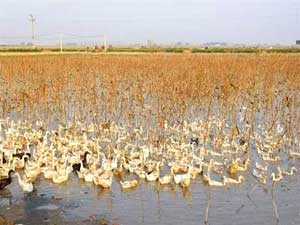Many farming households in various regions, especially in the Mekong Delta, have experience in raising ducks alongside fish in rice fields, which brings benefits in diversifying products on rice cultivation, increasing crop yields, and reducing chemical fertilizers due to the duck manure. Ducks and fish also eat insects and pests that harm rice, thus enhancing economic efficiency and improving the quality of rice, among other advantages.
Preparing the Rice Field
 |
|
(Illustrative photo: nea.gov) |
The fields must have solid dikes that do not erode. The dikes should be raised higher than the maximum water level by 0.5 meters. The water level in the rice field should typically be maintained at 30-35 cm. Surrounding the field, there should be a trench that is 1-1.2 meters wide, 1 meter deep, and has a fish pond (or reservoir) accounting for 7-8% of the field area to allow fish to live, keep them shaded, and facilitate harvesting when the time comes. When it’s time to harvest, the fish are collected and moved from the field to the pond for catching.
On the surface of the pond, a wooden cage should be built to keep the ducks at night and when the weather is bad, preventing them from being released into the rice field. The feed that falls from the ducks and their manure serves as food for the fish. Brush and undergrowth in the field should be cleared, and snakes and other pests such as snakehead fish should be eliminated.
Fish Farming
The water level in the rice field is not deep, making it susceptible to weather impacts and sunlight; hence, it is necessary to choose fish breeds that can tolerate heat and acidity, and are accustomed to living and foraging at the bottom. When stocking, fish should be slightly larger, such as carp at 6-8 cm, tilapia, and catfish at 3-5 cm. For a single cropping rice field where fish are released once, the stocking density per square meter should be approximately 30% catfish, 30% carp, and 40% tilapia. In fields with heavy acidity, only 30% tilapia and 50% catfish should be released.
Duck Farming
Layer Ducks:
For meat duck breeds: 40-50 ducks per 1,000 m2 of rice field. For egg-laying breeds: 60-70 ducks per 1,000 m2 of rice field. Keep 3-4 ducks per m2 in the cage.
Meat Ducks:
Ducklings should be kept in a wind-protected area during the first week. In the second week, the ducks can be moved to the cage. For the first four weeks, maintain 20 ducks per m2, and for ages 5-10 weeks, reduce to 10-12 ducks per m2. Release 60-80 ducks per 1,000 m2 into the rice field.
Method of Releasing Ducks into the Rice Field:
In the first month after planting rice, ducks should not be released; only fish should be introduced into the fields.
After the first month, when the rice begins to flower and the root system is well developed, ducks can be released into the field. During the flowering period, ducks should only be allowed to graze in the pond and surrounding trenches, while fish utilize the pollen and other microorganisms that fall from the rice.
During the rice harvest period, ducks are released into the field to take advantage of fallen grains and other feed. After harvesting the rice, continue to raise fish for a while before harvesting them.


















































